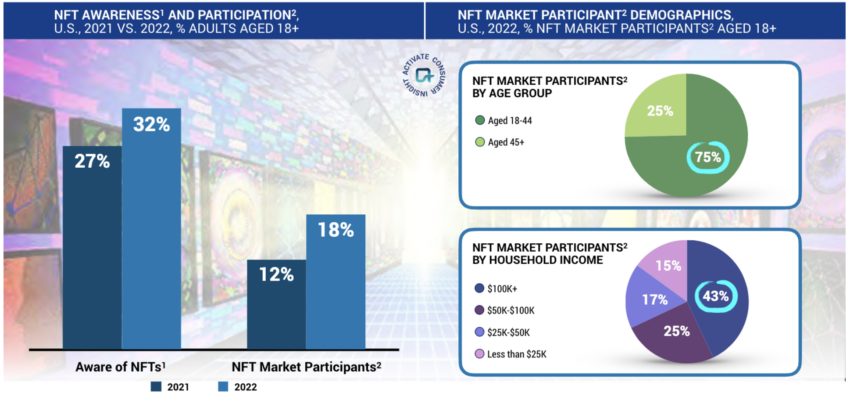What can you expect in 2023?
A new report from Activate Technology reveals that the non-fungible token (NFT) and metaverse hype is over, and that both sectors will need targeted corporate interest going forward.
The future offers new uses for NFTs to help businesses build brand loyalty, while the metaverse will need sustained business development.
According to a new report released by the company, NFTs have passed the peak bubble. Consequently, the hype around the square will gradually subside.
NFTs will become mature products, with blockchain and Web3 providing greater utility for tokens. Companies will also use the space to build communities around their brands. Buyers will also benefit from a sense of belonging.
Starbucks already offers the Starbucks Odyssey experience that uses NFT collectible stamps that will give owners access to unique coffee experiences.
In addition, the report revealed the shift in the demographics of current NFT market participants. It defines participants as those who “researched, discussed, browsed, bid, bought, displayed, sold or created NFTs in the last 12 months.”
The number of US participants increased from 12% in 2021 to 18% in 2022. Yet less than a third of the US population is still unaware of what NFTs are. Forty-three percent of NFT participants came from affluent households with incomes of $100,000 or more.

NFT sales on primary and secondary marketplaces, excluding LooksRare, have surpassed $23B in 2022. Most NFT owners are now buying them for display on social media and collections. This is in contrast to earlier in the NFT cycle, when people bought and traded NFTs as speculative investments.
Only 51% of adults 18 or older bought them as investments in 2022, compared to 76% last year. Nineteen percent more buyers use them for display purposes, while 4% more treat them simply as digital collectibles.
Twelve percent fewer buy them because of novelty. Two percent more buy them to support an artist or athlete.
According to Activate Technology, in addition to the NFT bubble being over, the metaverse hype cycle is also over, with companies needing to identify opportunities and commit business resources to this space. Businesses must now focus on interoperability between virtual worlds to fully exploit the benefits of the metaverse.
The foundation of the metaverse has already been more than twenty years in the making through immersive virtual worlds in games. About 77% of gamers in the US have engaged in non-gaming activities within gaming in the past year. They have created avatars and personalization and bought virtual goods.
Players in China, Japan and South Korea have spent a combined 30 hours a month playing games such as Roblox, Minecraft and Fortnite that have certain metaverse elements. These elements include an immersive experience, social interactions, mixed reality, identity and an in-game economy.
Virtual reality and augmented reality will not reach mass adoption and will not be the future of the metaverse.
“We expect to see significant and sustained investment in innovation over the next few years,” the report concludes.
Disclaimer
All information on our website is published in good faith and for general information purposes only. Any action the reader takes on the information contained on our website is strictly at their own risk.


